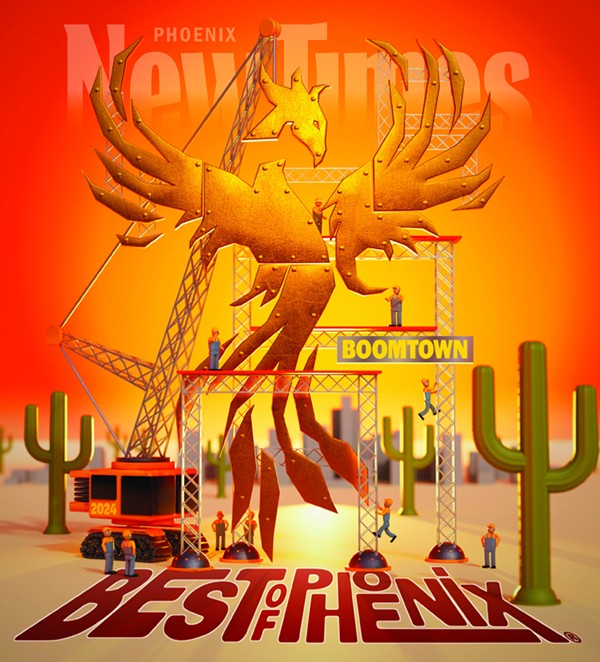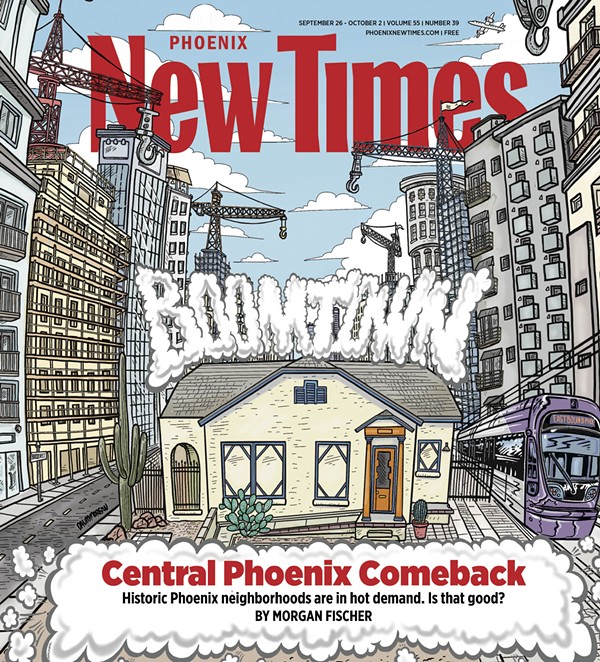Maybe it was opening their own stadium. Or the return of dollar beer nights. Or a roster overhaul. Whatever the reason, Phoenix Rising FC rose to the occasion and brought home a championship trophy. And for that, they've earned a special spot in the hearts of sports fans across metro Phoenix. The championship run last year had its fits and starts — and near collapses. But the team that entered the playoffs in sixth place never gave up, winning the club's first title in a penalty kick shootout. The Rising lost their head coach and most players from the championship roster, leading to a tough season this year. (They've already fired the replacement coach.) But the game-day experience keeps the fans coming back, thanks to a busy schedule of theme nights, food trucks and fun.
Best Use of a Singlet
Richard Figueroa
The 125-pound mass of college wrestling muscle won ASU's first individual national championship in five years and the 11th individual title in team history in March. It came after a stellar season that earned him 2024 Pac-12 Wrestler of the Year honors. The redshirt junior from California is quickly becoming a wrestling legend for his work on the mat. Watching this fierce competitor take down opponent after opponent is made better when he flexes those biceps in victory. Nabbing the national championship brought more honors for him, including Tempe Mayor Corey Woods declaring that March 23, 2024, would be known as Richard Figueroa Day and getting to throw the first pitch on ASU Night at an Arizona Diamondbacks game in August. Even better is that he returns to the mat when wrestling season opens in November to defend his championship.
Best Place to Watch a Spring Training Game
Salt River Fields at Talking Stick
Sloan Park, the spring home of the Chicago Cubs, is the newest stadium in the Valley's baseball landscape. It's certainly a top-notch facility, but when it comes to the best in Arizona, the 13-year-old Salt River Fields continues to hit home runs. Located on the Salt River Pima-Maricopa Indian Community and home to the Diamondbacks and the Colorado Rockies, the stadium remains in terrific shape. There are great food options, a unique collection of cactuses on the batter's eye in center field and, from certain angles, a wonderful view of Camelback Mountain. While the Mesa-set Sloan Park tends to get overcrowded with fans, Salt River Fields never feels too full. Pick any seat for a terrific view of the action, or relax with a picnic blanket on the outfield lawn. There's also easy access to the backfields, should you want to watch the Rockies or Diamondbacks train before a game.
- 7555 N. Pima Rd., Scottsdale, 85258 Map
Best Secret Spot at Footprint Center
Hideaway Lounge
Ask any staff member at Footprint Center where Hideaway Lounge is, and they probably won't know. But it's on suite level B, between the 100 and 200 levels. You can take the elevator or escalator, and anyone with a ticket to the game can hang out in the lounge and watch the game from there. It's standing room only for anyone who doesn't have a seat ticket for the lounge, but the view is still a lot better than from the nosebleed seats. (Note: Security will not allow you to stand in front of people who are sitting down, thus blocking their view and the walkway.) The lines for the bars are a lot shorter than on the concourses, too.
- 201 E. Jefferson St., Phoenix, 85004 Map
- 602-379-2000
- www.phoenixsunsarena.com/
Best Disappearing Act
Arizona Coyotes
In April, the Coyotes released mockups of a new arena they hoped to build in Phoenix. Within days, news leaked that the team was moving to Salt Lake City. After years of unsuccessfully looking for someone to build them a new facility — and after one season playing in the 5,000-seat Mullett Arena at Arizona State University — the team's 27-year history in the Valley was over. The news broke with just one home game left on the schedule, turning the team's season finale into a wake. Then, in a flash of smoke, the team was gone. A disappearing act needs a good reappearance to complete the trick, but a half-hearted attempt to revive the Coyotes by owner Alex Meruelo failed in June when a land deal in Phoenix fell through.
Best Eulogy
Todd Walsh
With about a week's notice, Todd Walsh had to summarize the nearly three-decade existence of a beloved Arizona sports franchise and the last 27 years of his own sports broadcasting career. The Arizona Coyotes had just wrapped up their final game of the season. Days earlier, they'd announced the team would move to Salt Lake City. Walsh had covered the team on the air since it came to the Valley in 1996, and over five poignant minutes on the postgame show, he bid an emotional and professional farewell to a franchise that was leaving a dedicated fanbase, a local media contingent and him behind. "Hockey gave me a personal and professional purpose," Walsh said, sharing how the game and its people buoyed him after the death of each of his parents. With admirable poise and without a single verbal pause, Walsh helped fans through their grief just like hockey had helped him through his. "A good story lasts forever," he told them. "However, sometimes the ending just isn't what you want it to be."
Best Sports Mascot
Sparky the Sun Devil
The Valley's sports mascots leave a lot to be desired. Big Red, the Arizona Cardinals' mascot, is one of two anthropomorphic cardinals in major professional sports. Howler the Coyote has moved to a farm upstate. The Suns' Gorilla is famous but nonsensical, and the Diamondbacks having a bobcat mascot makes sense only if you know the tortured explanation for it. (Chase Field was originally named Bank One Ballpark – or B.O.B. for bobcat. Again, the team is named after a snake.) But Sparky is wholly original. Sure, there may be a few other devil mascots out there, but there's only one Sun Devil. He has more history than most of his counterparts in town, and he's certainly unique. And there's no mistaking what team he represents — something the Valley's other mascots would have a hard time claiming.
Best Scofflaws
ASU Athletics
We're No. 1? It's been a while since the Sun Devils won anything in a major sport — no offense to the men's swimming and diving team, which won an NCAA title this year — but ASU landed atop a dubious leaderboard this year. In April, the NCAA penalized the Sun Devils for illegal recruiting during the pandemic under former football coach Herm Edwards. As a result, ASU is now tied with Southern Methodist University for the most major infractions (10) in NCAA history. The obvious solution: Go for 11. Bring back a poorly disguised James Harden on the basketball court. Start a sign-stealing scheme on the baseball diamond. Give every student-athlete a sports betting app, $500 and no supervision. It's time to make history.
Best Inability to Read the Room
Ken Kendrick
It should have been a celebratory moment. Spring training had sprung, and the Diamondbacks were coming off a surprise trip to the World Series. They'd just executed an exciting offseason, spending tens of millions of dollars to bolster a young and exciting team that had just brought postseason baseball back to the Valley. Then Diamondbacks managing partner Ken Kendrick stepped in front of a bunch of microphones and issued a veiled threat to move the team. "We may run out of time in Phoenix," Kendrick warned, raising the specter of relocating the team out of state. There are cities across the country, he explained, that "would certainly be very happy, you know, with, frankly, a successful, existing franchise." Arizona Republic columnist Phil Boas called it Kendrick channeling "his inner mob boss." In a rarity when it comes to Boas' work, he was right.
Best Inability to Be in the Room
Alex Meruelo
As the Coyotes played a final, emotional game in the Valley in April, the man responsible for their impending exit was nowhere to be found. Alex Meruelo's ownership of the Coyotes lasted less than five years, a span that saw the team abandon their home at Gila River Arena in Glendale and then strike out multiple times at finding a shiny new home. As fans, players and media members bid a tearful farewell as the Coyotes took the ice in Arizona for one last time, Meruelo didn't show. He was too busy finalizing a billion-dollar deal to sell and relocate the team, he told a local sports radio station. If you're going to rip a team away on short notice, at least be there at the end to take your medicine.





